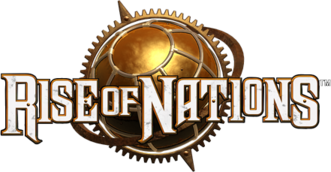
The many land units that appear throughout the game.
The Land Units group includes the majority of all the units in the game.
About 75% of the world is covered in water. The remaining 25% consists of land and other dry areas. Since humans are not permanently aquatic animals, naturally we live on this land, and when two groups of walking, talking, thinking beings meet, there are bound to be conflicts. With this in mind, one could say that the Army is the oldest branch of the military. For as long as humans have coexisted with each other, there has been conflict and following that has been the Army. Without the Army, a country could not last for too long. Its age and its influence has made the Army an irreplaceable aspect of our lives today, and shall do so for far into the future.
Application[]
Rise of Nations seems to agree with the statement that the Army is the oldest surviving branch of the military, since the first military units that are available to the player are Slingers, a light foot soldier unit. The army, particularly the infantry, is essential for the capture of enemy cities, and it is only through the army that cities can be destroyed (since razing a city is not possible until the army captures the city).
The Land Units of Rise of Nations are the most diverse of all the units in the game. The vast majority of them are Military, which can be grouped into four categories, some of which can then be grouped further into sub-categories. There is also two small groups of Non-Military units (support and civilians).
Military[]
Infantry  []
[]
The Infantry has been an integral part of the Army, and should remain so for years to come, as humans patrolling the ground can do things that even the most maneuverable, the most heavily armed, or the most heavily armored vehicle cannot do. In Rise of Nations, they are as essential for capturing cities as Siege Units are.
Light / Gunpowder / Modern Infantry 

 []
[]

Light / Gunpowder / Modern Infantry of all ages.
- Slingers -
 Ancient Age, lightly armed and fast-moving, slingers hurl rocks at their enemies with deadly velocity.
Ancient Age, lightly armed and fast-moving, slingers hurl rocks at their enemies with deadly velocity. - Javelineers -
 Classical Age, now armed with the more lethal Javelin, these soldiers hurl spears at their enemies with lethal accuracy.
Classical Age, now armed with the more lethal Javelin, these soldiers hurl spears at their enemies with lethal accuracy. - Elite Javelineers -
 Medieval Age, the Javelineers are now more exhaustively trained to result in a new breed of solider who takes care of his enemy with new efficiency.
Medieval Age, the Javelineers are now more exhaustively trained to result in a new breed of solider who takes care of his enemy with new efficiency. - Arquebusiers -
 Gunpowder Age, originating from Portugal, the Arquebusiers were trained in the use of the first Gunpowder weapons, a crude musket known as the Arquebus.
Gunpowder Age, originating from Portugal, the Arquebusiers were trained in the use of the first Gunpowder weapons, a crude musket known as the Arquebus. - Musketeers -
 Enlightenment Age, With the advent of flintlock muskets, the Musketeers became reknowned for their deadliness.
Enlightenment Age, With the advent of flintlock muskets, the Musketeers became reknowned for their deadliness. - Riflemen -
 Industrial Age, with the advent of Rifling, soldiers could now use their weapons with more accuracy that before, resulting in a more lethal killing force.
Industrial Age, with the advent of Rifling, soldiers could now use their weapons with more accuracy that before, resulting in a more lethal killing force. - Infantry -
 Modern Age, in WWII, infantry were the most indispenseable part of the Army, as they caused more victories than the tanks themselves.
Modern Age, in WWII, infantry were the most indispenseable part of the Army, as they caused more victories than the tanks themselves. - Assault Infantry -
 Information Age, with improved radio communications, weapons, and non-lethal fighting tactics, the infantry has become more dangerous today than it has ever been, and is even capable of taking targets without killing people...but where's the fun in that?
Information Age, with improved radio communications, weapons, and non-lethal fighting tactics, the infantry has become more dangerous today than it has ever been, and is even capable of taking targets without killing people...but where's the fun in that?
See also: Unique Light Infantry / Unique Gunpowder Infantry / Unique Modern Infantry
Heavy Infantry 

 []
[]
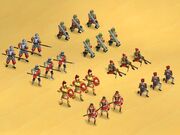
Heavy Infantry of all ages.
- Hoplites -
 Ancient Age, clad in shining bronze armor, the hoplites were among the most formidible of warriors with their sharp spears and large shields.
Ancient Age, clad in shining bronze armor, the hoplites were among the most formidible of warriors with their sharp spears and large shields. - Phalanx -
 Classical Age, when many hoplites marched together in a column, they were know as the fearsome phalanx, symbol of Alexander the Great's power.
Classical Age, when many hoplites marched together in a column, they were know as the fearsome phalanx, symbol of Alexander the Great's power. - Pikemen -
 Medieval Age, a pike is a very long spear, ideal for skewering a knight off of his horse.
Medieval Age, a pike is a very long spear, ideal for skewering a knight off of his horse. - Elite Pikemen -
 Gunpowder Age, with some intensive training, the Pikemen became even more lethal in their craft.
Gunpowder Age, with some intensive training, the Pikemen became even more lethal in their craft. - Fusiliers -
 Enlightenment Age, from the French word fusil which meant "rifle", these soldiers aimed for the cavalrymen charging at their friends in the front line with lethal accuracy.
Enlightenment Age, from the French word fusil which meant "rifle", these soldiers aimed for the cavalrymen charging at their friends in the front line with lethal accuracy. - Anti-Tank Rifle -
 Industrial Age, the invention of armor-piercing rounds gave rise to the Anti-Tank Rifle, designed specifically to make short work of the lightly armored tanks of the era.
Industrial Age, the invention of armor-piercing rounds gave rise to the Anti-Tank Rifle, designed specifically to make short work of the lightly armored tanks of the era. - Bazooka -
 Modern Age, the famous American invention that revolutionized the world of Anti-Tank warfare, it was used to great effect in WWII, and is the predecessor of all shoulder-mounted rocket launchers.
Modern Age, the famous American invention that revolutionized the world of Anti-Tank warfare, it was used to great effect in WWII, and is the predecessor of all shoulder-mounted rocket launchers. - Anti-Tank Missile -
 Information Age, a generic term used to describe one of the world's greatest military inventions to combat armored warfare.
Information Age, a generic term used to describe one of the world's greatest military inventions to combat armored warfare.
See also: Unique Heavy Infantry
Foot Archers 

 []
[]
The Bow and Arrow was the world's first ranged weapon, a weapon capable of killing from a distance by means of self-propulsion (i.e. not thrown). This effect, though originally used to hunt efficiently, was soon seen by its more sinister potential: as a weapon of war. So, with this in mind, the bow and arrow became the classic weapon of the Middle Ages, ranging from the simple bows used in the early ages to the feared English Longbows, whose arrows could pierce armor to the insanely strong Crossbow.
- Bowmen -
 Ancient Age, simple soldiers who are armed with a bow and some arrows.
Ancient Age, simple soldiers who are armed with a bow and some arrows. - Archers -
 Classical Age, soldiers that are much more trained with a bow.
Classical Age, soldiers that are much more trained with a bow. - Crossbowmen / Heavy Archers -
 Medieval Age and
Medieval Age and  Gunpowder Age, soldiers that start to use crossbows still with arrows.
Gunpowder Age, soldiers that start to use crossbows still with arrows.
See also: Unique Foot Archers
Machine Guns  []
[]
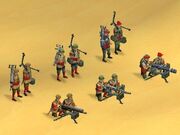
Machine Guns of all ages (packed and deployed).
The History of the Machine Gun is far more bloody. The first idea of a repeating gun was devised by Dr. Richard J. Gatling, the designer of the famed multi-barreled Gatling Gun. However, this gun was not able to reload itself and provide truly automatic fire. That honor would be given to Hiram Maxim, whose Maxim Machine Gun caused more casualties in WWI than any other weapon. With the inception of automatic fire, warfare was changed forever. Big charges were no longer practical when the enemy could cut down everyone with only one soldier and a machinegun. With this in mind, the Machine Gun is the most feared anti-personnel weapon on the battlefield today.
- Machine Gun -
 Industrial Age, soldiers that start using rapid guns that launches dozens of bullets.
Industrial Age, soldiers that start using rapid guns that launches dozens of bullets. - Heavy Machine Gun -
 Modern Age, machine guns became more accurate and gained a faster rate of fire.
Modern Age, machine guns became more accurate and gained a faster rate of fire. - Advanced Machine Gun -
 Information Age, being capable of firing thousands of rounds per minute, most modern machine guns pose a very serious threat to all kinds of infantry.
Information Age, being capable of firing thousands of rounds per minute, most modern machine guns pose a very serious threat to all kinds of infantry.
See also: Unique Machine Guns
Flamethrowers  []
[]
- Flamethrower -
 Industrial Age, slow-moving and short-ranged soldiers that are highly effective against buildings.
Industrial Age, slow-moving and short-ranged soldiers that are highly effective against buildings.
Militia 
 []
[]
Cavalry 
 []
[]
Light Cavalry 
 []
[]
- Light Horse -
 Classical Age
Classical Age - Light Cavalry -
 Medieval Age
Medieval Age - Elite Light Cavalry -
 Gunpowder Age
Gunpowder Age - Hussar -
 Enlightenment Age
Enlightenment Age
See also: Unique Light Cavalry
Heavy Cavalry 
 []
[]
- Cataphract -
 Classical Age
Classical Age - Knight -
 Medieval Age
Medieval Age - Heavy Knight -
 Gunpowder Age
Gunpowder Age - Cuirassier -
 Enlightenment Age
Enlightenment Age
See also: Unique Heavy Cavalry
Ranged Cavalry 

 []
[]
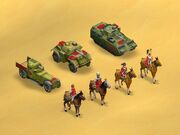
Ranged Cavalry of all ages.
- Horse Archer -
 Classical Age
Classical Age - Heavy Horse Archer -
 Medieval Age
Medieval Age - Dragoon -
 Gunpowder Age
Gunpowder Age - Carabineer -
 Enlightenment Age
Enlightenment Age - Armored Car -
 Industrial Age
Industrial Age - Armored Scout Car -
 Modern Age
Modern Age - Armored Cavalry -
 Information Age
Information Age
See also: Unique Ranged Cavalry
Elephants 
 []
[]
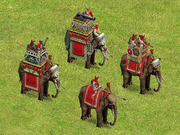
Elephants of all ages.
War elephants were trained and guided by humans for combat. Such elephants were mostly used for charging the enemy, breaking their ranks and instilling terror and fear. War elephants played a critical role during several key battles in the past, especially in Ancient India. Later, during classical antiquity they were used in ancient Persia and in the Mediterranean world. In some regions they remained useful on the battlefield throughout the Middle Ages. But their use eventually declined with the spread of firearms in early modern warfare. After that, war elephants were mostly restricted to non-combat labor roles and being used for minor ceremonies. However, In some parts of the world, war elephants continued to be used in combat well into the 19th century.
- War Elephant -
 Classical Age
Classical Age - Mahout -
 Medieval Age
Medieval Age - Gun Mahout -
 Gunpowder Age
Gunpowder Age - Culverin Mahout -
 Enlightenment Age
Enlightenment Age
Tanks 
 []
[]
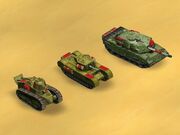
Most common tanks of all ages.
A tank is an armored, tracked military vehicle designed to engage enemy troops, vehicles and fortifications with direct fire. They were first developed during World War I by the British. The tank's original purpose was to break the trench warfare stalemate that had bogged down the Western Front of the war. In the years following World War I, tank warfare continued to be a crucial part of many conflicts. Modern tanks combine mobility, armor and firepower to ensure maximum survivability and lethality on the battlefield. The combination has resulted in one of the most effective land weapon systems. But the rise of effective infantry anti-tank weapons has since eroded the dominance the tank enjoyed during the middle of the 20th century. Tanks remain vulnerable to airstrikes and helicopters, as well as other tanks, anti-tank missiles, heavy artillery and anti-tank mines or Improvised Explosive Devices.
See also: Unique Tanks
Artillery Weapons 


 []
[]
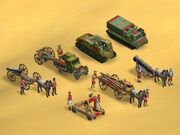
Artillery Weapons of all ages.
- Catapult -
 Classical Age
Classical Age - Trebuchet -
 Medieval Age
Medieval Age - Bombard -
 Gunpowder Age
Gunpowder Age - Cannon -
 Enlightenment Age
Enlightenment Age - Artillery -
 Industrial Age
Industrial Age - Howitzer -
 Modern Age
Modern Age - Rocket Artillery -
 Information Age
Information Age
See also: Unique Artillery Weapons
Anti-Aircraft Units 
 []
[]
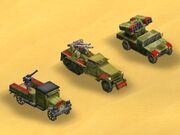
Anti-Aircraft Units of all ages.
Anti air is actually a broad term covering a variety of attacks capable of engaging airborne targets from the ground including pointing even a rifle at the sky. However engineers have came up with various techniques, involving Artillery used in this fashion, or dedicated weapons that are designed especially for this role. AA was just as early as when manned flight became a common sight on the battlefield. Balloons served as a powerful recon asset, when working out an enemy's setup.
- Anti-Aircraft Gun -
 Industrial Age
Industrial Age - Anti-Aircraft Battery -
 Modern Age
Modern Age - Anti-Aircraft Missile -
 Information Age
Information Age
